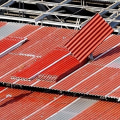The most durable types of roofing are slate and clay tiles, but they are more expensive than materials such as metal or wood. Functional roofing alternatives, such as green roofs and solar shingles, are among the most expensive types. Replacing an old roof is one of the best and most profitable ways to invest in a home. Before making any decision, you should consider how long you want your roof to last, whether you want it to complement the design of the house, the price you want to pay or if you prefer organic and natural products.
They are usually made of cedar, but can also be made from other rot-resistant woods, such as redwood. Wood gives a natural look, but has a short lifespan and requires periodic maintenance. Made from natural clay baked in a kiln, they are made from natural materials, but they require a lot of energy to be manufactured. They can be durable and low maintenance, but brittle and can break.
They are less expensive than clay tiles and can last a long time. They are made from natural materials, but they require significant energy for their manufacture. It can be made of steel, aluminum, copper or zinc. Metal can be recycled when replaced, but requires significant energy to manufacture.
Its durability depends on the material. Slate is one of the oldest roofing materials. The value of natural slate lies in its impermeability, durability and versatility. A good quality slate roof is very durable and will perform better than other roofing materials.
In addition, roofing slates are fireproof, immune to insects, fungi and any type of microorganisms. It is the most durable natural building material in history. On the other hand, the natural slate look is one of its strongest attributes. Its natural color, texture and grain, when applied to a pitched roof, provide a clean, sculpted and surprisingly beautiful appearance.
Don't miss the latest architectural designs with natural materials. Asphalt roll roof is made from large rolls of the same material that is used in asphalt shingles. Used for relatively flat plots, such as angled shed roofs, the roll roof is installed by placing strips along the roof in overlapping rows. Asphalt roller roofs can be expected to last 5-10 years at most.
Getting maximum roof life is just a matter of keeping it free of debris and quickly repairing any punctures or damage that occurs. Asphalt roll roofs are typically installed on roofs with a relatively flat peak, so a 2,000-square-foot home will have a roof area very close to 2,000 square feet. Composite asphalt shingles can be expected to last 15 to 40 years, depending on the quality of the materials chosen. Some tile roofs can last up to 50 years.
Most tile roof manufacturers offer a range of products in different weights and different life expectancy. Manufacturers such as Owens Corning, GAF or Certainteed come with high-end guarantees that last half a century. Wooden tile roofs are made of thin wedge-shaped pieces of natural wood, such as cedar or yellow pine, which are cut from logs. They are an extremely attractive ceiling, but they are difficult to install and are not suitable for most DIYers.
Keep in mind that increasing fire hazards in some regions have led to legal restrictions on the use of wooden roofing materials. They are not a good option anywhere where there are seasonal wildfire risks. Wooden tile roofs have an average of 25 to 30 years of longevity, although a longer service life is sometimes achieved in places where the roof experiences mild conditions and remains free of debris. Meticulously maintained, wooden tile roofs can last 50 years.
To extend the life of a wooden shingle roof, be sure to replace split and cracked shingles immediately, and keep the roof free of moss. Wood shingles are a thicker material than wooden shingles, and can be expected to resist weather and UV rays better than wood shingles. They are not suitable for most DIY enthusiasts, which requires professional installation. Like wooden shingles, shaking may be restricted in regions where wildfires are a known hazard.
Wooden ceilings can be expected to last 35-40 years, although a longer service life is not rare. To maximize the service life, it is necessary to take care of them and practice proper maintenance. There is no option for any wooden roofing material that will allow you to never maintain it again. Remove debris as soon as it falls on the roof.
Replace curly, cupped or split shakes immediately. Clay tile roofs typically last 100 years or more when properly maintained. The disadvantage of tile roofs is not decay, as with wood beating or shingles, nor the slow removal of mineral grains, as is the case with composite tiles. Rather, cracking is what can condemn tile roofs.
Avoid walking on the shingle roof as much as possible. When efflorescence develops, as is often the case with terracotta, wipe it with a clean, dry towel. Cover the tiles with a transparent alkyd primer. Replace cracked and broken tiles as soon as you detect them.
One, asphalt shingles are versatile because they come in different colors and profiles. They may even look like cedar shingles or slate roofs. Two, many homeowners can afford asphalt shingles, depending on the type (3-tab shingles or architectural shingles). While not all roofing contractors install a wooden roof, we do it here at Roper Roofing.
Cedar wood slats cannot be installed on flat surfaces, only on inclined surfaces. Asphalt shingles will last between 15 and 30 years. They are by far the most popular roofing material due to their cost-effectiveness. This roofing material should last between 30 and 50 years.
Wooden shingles are usually made from fire-resistant woods, such as cedar or redwood. When it comes to energy efficiency, wood is a natural insulator, wood shingles are naturally about twice as efficient as asphalt shingles. And because they are 100% natural, asphalt shingles are one of the most sustainable roofing materials on the market. Most metal roofs are not only created from recycled materials, but many are also 100% recyclable.
A roof made of slate can last between 75 and 150 years. One of the oldest roofing materials, slate is also one of the most expensive. Slate is one of the most expensive materials because it will last for most of a century, and if the roof is well built, more than 150 years. Because of this, slate is an incredibly sustainable roofing material.
Many clay and terracotta roofs sit on concrete and stucco houses, and rightly so. These materials are heavy and need solid bases to withstand loads and resist wind and earthquakes. Another consideration with terracotta roofs is that cold and humid weather often causes tiles to break. Newer processes and treatments prevent this from happening, but it's a good idea to check durability and temperature resistance.
Made of metal? Clay tiles? Cedar tiles? Here are all the answers. And a hot day in the life of a good roof should include releasing, not storing or absorbing, the sun's rays. They require a strong roof structure sufficient to support the weight and must be installed by qualified professionals. Most regions of Spain, Mexico, Italy, and the southwestern United States have tons of heat and sun, and abundant Mission- or Spanish-style terracotta roofs.
Most metal roofs are steel and aluminum, with copper options more in the high-end, and most types need to be treated for corrosion resistance. Today, you will still be able to find slate roofing systems in houses that were built about a hundred years ago. Made of steel, copper, zinc alloy or aluminum, metal roofs are slightly more expensive than their asphalt and wooden counterparts. But it is more suitable for sheds, garages and perhaps porch roofs, and it is not a very good solution for most house roofs.
As with most home improvement options, there is a direct relationship between quality and cost, and in the case of ceilings, quality usually translates as longevity. If installed at an angle without slope planning or glare considerations, no matter how cold the white metal roof is, it will not be cold for nearby residents and drivers who are blinded by reflected light. Currently, although there are many manufacturers who offer solar panels for their roof, Tesla is the only manufacturer that offers a solar glass roof. Here you can find an overview of the different types and the most suitable roofing materials for each roof shape.
The different claims regarding ease of application, durability, and energy savings vary by manufacturer, but researching cold roof layers or coatings and consulting with a local roofing contractor and local building codes can help classify what works well into different regions. . .










